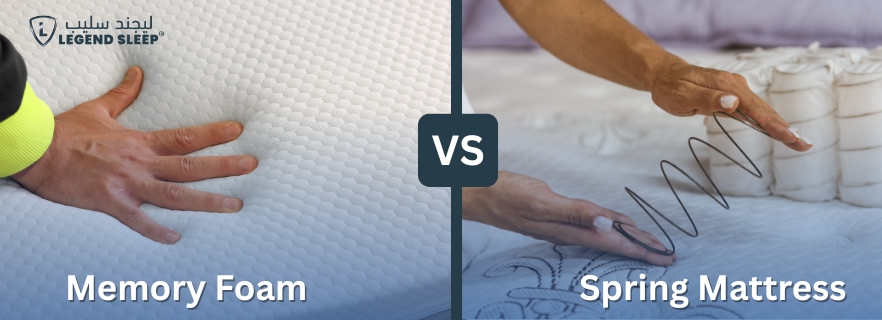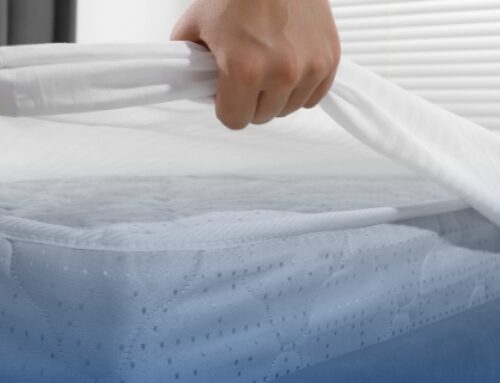
Choosing a mattress shouldn’t feel like a science exam. Below is a clear, brand-neutral guide that explains how memory foam and spring mattresses perform on support, pressure relief, cooling, motion isolation, durability, and price—plus quick picks from the Legend Sleep.
range to make shopping easier.
Quick Match Guide
- Side sleepers / pressure-point pain: Memory foam usually wins for deep contouring and shoulder/hip relief.
- Back & stomach sleepers / need a flatter surface: Many prefer springs (especially pocket springs) for lifted support and easier movement.
- Hot sleepers & humid climates: Springs breathe naturally; modern foams help but airflow in springs is still hard to beat.
- Light sleeper sharing a bed: Memory foam minimizes partner motion transfer best.
- Sit on the edge often / like a bouncy feel: Springs (with reinforced edges) feel sturdier around the perimeter and more responsive.
- Tight budget: Both categories have options; entry-level springs are often the most cost-effective.
How They Work (and Why It Matters)
Memory Foam
Viscoelastic foam softens with heat and pressure, “hugging” your curves to spread weight evenly. This reduces pressure points and absorbs motion, but the close contour can feel warmer unless engineered foams or breathable covers are used.
Try from Legend Sleep:
- American Night Mattress
- – a plush, contouring memory-foam feel.
- Dark Knight Mattress
- – supportive memory-foam comfort with a premium look.
Spring (Innerspring)
A core of steel coils lifts you up rather than letting you sink in. Air moves freely through the coil unit for natural cooling and easy mobility.
- Pocket springs: Each coil is fabric-wrapped, letting them move independently for better pressure relief and reduced motion transfer.
- Bonnell springs: Hourglass coils joined together; traditional, bouncy, budget-friendly support.
Explore Legend Sleep’s spring lineup (pocket & Bonnell options):
Roll & Hybrid-Style:
Everyday to Premium Support:
- marvi Mattress
- Lazy Night Mattress
- Sleep Dose Mattress
- SleepyHead Mattress
- Me and You Mattress
- Timeless Mattress
- Rest Moments Mattress
- Washington Mattress
- Boulevard Night Mattress
- Legend Sleep Classic Mattress
- White House Mattress
Choose by Sleep Position & Body Type
Side Sleepers
- Go memory foam if you feel pressure on shoulders/hips or wake with numb arms.
- Pocket spring works well if you want contour + easier turning.
Back Sleepers
- Look for medium to medium-firm. Foam can cradle the lumbar; pocket springs keep you lifted and aligned.
Stomach Sleepers
- Prefer firmer, flatter surfaces to prevent hip sink. Many stomach sleepers feel better on springs or a firmer foam.
Body Weight
- Light (<60 kg): Softer foams can feel comfier; too-firm springs may feel hard.
- Average (60–90 kg): Medium to medium-firm in either category suits most.
- Heavy (>90 kg): Consider firmer foams or robust pocket springs with reinforced edges for stability and longevity.
Cooling in Warm Climates (like KSA)
If you run hot or your room is warm:
- Springs have built-in airflow—a strong advantage.
- Foams can sleep cooler if paired with breathable covers, open-cell/ventilated foams, and lightweight bedding.
- A mattress protector that breathes well helps keep things fresh without trapping heat (see protectors on Legend Sleep )
For Couples: Motion & Edge
- Motion isolation: Memory foam excels—less ripple effect when your partner moves. Pocket springs also do well.
- Edge sitting: Spring mattresses with edge reinforcement feel sturdier if you sit or sleep near the edge frequently.
Budget & Value
- Best value under tight budgets: Bonnell spring options are often the most economical.
- Balanced comfort + support: Pocket springs hit a sweet spot for many.
- Premium pressure relief or back comfort: High-quality memory foam or hybrid builds.
Legend Sleep Picks (Start Here)
If You Want Deep Pressure Relief (Memory Foam)
- American Night Mattress
- : Plush, contouring comfort for side sleepers and pressure-point relief.
- Dark Knight Mattress
- : A cushioned yet supportive memory-foam experience with a luxe finish.
If You Want Lifted Support & Airflow (Springs)
Browse our spring range and choose firmness/feel:
- Convenient Roll-Packed: Nova Roll, Nova Plus Roll
- Everyday Comfort: marvi, Lazy Night, Sleep Dose, SleepyHead
- Couples & Support Focus: Me and You, Timeless, Rest Moments
- Premium Finishes: Washington, Boulevard Night, Legend Sleep Classic, White House Mattress
Pro tip: If you’re unsure, shortlist two options—one foam, one spring—at similar firmness, then pick based on temperature preference, edge feel, and how easily you turn on the surface.
Care & Longevity Tips (Any Mattress)
- Rotate head-to-toe every 1–3 months (unless labeled “no-flip”).
- Use a breathable protector to guard against spills and dust.
- Pair with a supportive base; avoid broken slats or sagging frames.
- Give bed-in-a-box models 24–72 hours to expand fully after unboxing.
FAQs
Q: Which lasts longer—memory foam or spring?
A: Both can last years when built well. High-density foams resist body impressions; pocket springs with quality steel keep support over time. Edge reinforcement helps either type feel stable longer.
Q: Will memory foam make me hot?
A: Traditional foams can sleep warm, but breathable covers and modern foam formulations help. If you’re very heat-sensitive, a spring mattress’ airflow may suit you better.
Q: Pocket vs. Bonnell—what’s the difference?
A: Pocket coils move independently for better contouring and motion control. Bonnell coils are interconnected—springy, classic feel, and often more budget-friendly.
Which One to Pick
There’s no “best for everyone,” only best for you. If you want a gentle hug and top-tier motion isolation, start with memory foam (e.g., American Night, Dark Knight). If you prefer a cooler, lifted feel with strong edges and bounce, explore springs (see the full lineup above). Need help choosing? Reach out via our Legend Sleep we’re happy to match you with the right comfort.





